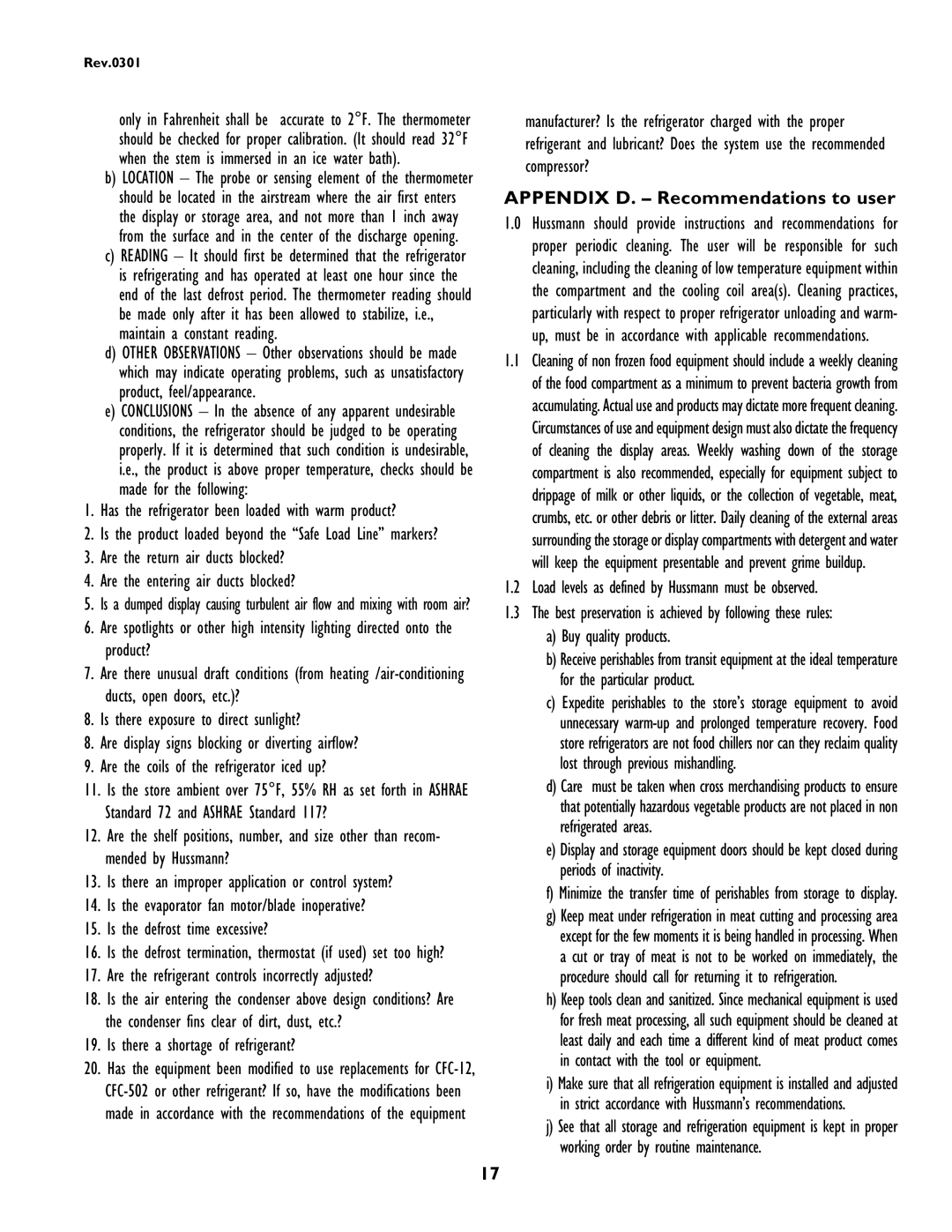Rev.0301
only in Fahrenheit shall be accurate to 2°F. The thermometer should be checked for proper calibration. (It should read 32°F when the stem is immersed in an ice water bath).
b)LOCATION – The probe or sensing element of the thermometer should be located in the airstream where the air first enters the display or storage area, and not more than 1 inch away from the surface and in the center of the discharge opening.
c)READING – It should first be determined that the refrigerator is refrigerating and has operated at least one hour since the end of the last defrost period. The thermometer reading should be made only after it has been allowed to stabilize, i.e., maintain a constant reading.
d)OTHER OBSERVATIONS – Other observations should be made which may indicate operating problems, such as unsatisfactory product, feel/appearance.
e)CONCLUSIONS – In the absence of any apparent undesirable conditions, the refrigerator should be judged to be operating properly. If it is determined that such condition is undesirable, i.e., the product is above proper temperature, checks should be made for the following:
1.Has the refrigerator been loaded with warm product?
2.Is the product loaded beyond the “Safe Load Line” markers?
3.Are the return air ducts blocked?
4.Are the entering air ducts blocked?
5.Is a dumped display causing turbulent air flow and mixing with room air?
6.Are spotlights or other high intensity lighting directed onto the product?
7.Are there unusual draft conditions (from heating /air-conditioning ducts, open doors, etc.)?
8.Is there exposure to direct sunlight?
8.Are display signs blocking or diverting airflow?
9.Are the coils of the refrigerator iced up?
11.Is the store ambient over 75°F, 55% RH as set forth in ASHRAE Standard 72 and ASHRAE Standard 117?
12.Are the shelf positions, number, and size other than recom- mended by Hussmann?
13.Is there an improper application or control system?
14.Is the evaporator fan motor/blade inoperative?
15.Is the defrost time excessive?
16.Is the defrost termination, thermostat (if used) set too high?
17.Are the refrigerant controls incorrectly adjusted?
18.Is the air entering the condenser above design conditions? Are the condenser fins clear of dirt, dust, etc.?
19.Is there a shortage of refrigerant?
20.Has the equipment been modified to use replacements for CFC-12, CFC-502 or other refrigerant? If so, have the modifications been made in accordance with the recommendations of the equipment
manufacturer? Is the refrigerator charged with the proper refrigerant and lubricant? Does the system use the recommended compressor?
APPENDIX D. – Recommendations to user
1.0Hussmann should provide instructions and recommendations for proper periodic cleaning. The user will be responsible for such cleaning, including the cleaning of low temperature equipment within the compartment and the cooling coil area(s). Cleaning practices, particularly with respect to proper refrigerator unloading and warm- up, must be in accordance with applicable recommendations.
1.1Cleaning of non frozen food equipment should include a weekly cleaning of the food compartment as a minimum to prevent bacteria growth from accumulating. Actual use and products may dictate more frequent cleaning. Circumstances of use and equipment design must also dictate the frequency of cleaning the display areas. Weekly washing down of the storage compartment is also recommended, especially for equipment subject to drippage of milk or other liquids, or the collection of vegetable, meat, crumbs, etc. or other debris or litter. Daily cleaning of the external areas surrounding the storage or display compartments with detergent and water will keep the equipment presentable and prevent grime buildup.
1.2Load levels as defined by Hussmann must be observed.
1.3The best preservation is achieved by following these rules:
a)Buy quality products.
b)Receive perishables from transit equipment at the ideal temperature for the particular product.
c)Expedite perishables to the store’s storage equipment to avoid unnecessary warm-up and prolonged temperature recovery. Food store refrigerators are not food chillers nor can they reclaim quality lost through previous mishandling.
d)Care must be taken when cross merchandising products to ensure that potentially hazardous vegetable products are not placed in non refrigerated areas.
e)Display and storage equipment doors should be kept closed during periods of inactivity.
f)Minimize the transfer time of perishables from storage to display.
g)Keep meat under refrigeration in meat cutting and processing area except for the few moments it is being handled in processing. When a cut or tray of meat is not to be worked on immediately, the procedure should call for returning it to refrigeration.
h)Keep tools clean and sanitized. Since mechanical equipment is used for fresh meat processing, all such equipment should be cleaned at least daily and each time a different kind of meat product comes in contact with the tool or equipment.
i)Make sure that all refrigeration equipment is installed and adjusted in strict accordance with Hussmann’s recommendations.
j)See that all storage and refrigeration equipment is kept in proper working order by routine maintenance.
